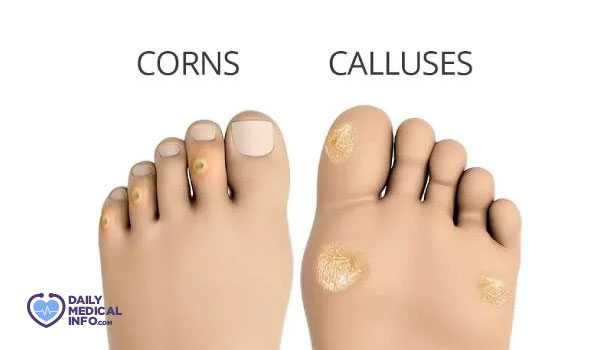Causes of corns (meat corns) and 3 ways to treat them
Have you noticed that thick, rough crust that appeared on the soles of your feet and wondered about it and want to get rid of its discomfort and pain? This condition is called corn or Flesh nail. In this article, learn about the causes of corns, their symptoms, various treatment methods, and how to prevent them.
What is a nail or a nail?
corn foot corn Its common name is also a callus, which is usually accompanied by another condition called callus (Callus), and the two cases are a hard and rough crust that forms on a small part of the skin in the soles of the foot or the top of the toes or between them. This problem usually occurs in the foot as a result of excessive friction or pressure on it more than usual, as a reaction from the body to defend itself against this overpressure.
Usually this problem is not considered a serious condition that you should worry about, but if you have diabetes, or you have poor blood circulation in the feet, you should consult a doctor immediately in the event of a nail appearing in order to avoid any possible complications that may occur to you because of it.
What is the difference between a corn and a callus (callus)?
Corns usually occur in or between the toes and appear in the form of a swollen and hard layer of skin, usually small and circular in shape. While calluses or calluses usually appear below the soles of the foot and affect a larger area and have an irregular shape of coarse and thick skin. Both can cause pain, but a person with corns feels more pain than someone with a callus.

What are the symptoms of corns?
- The appearance of a thick, rough part of the skin that looks like dead skin on the bottom of the foot.
- A hard bulge appears on your toes or between your toes.
- Sensation of pain under the skin.
- difficulty walking
- Sometimes the affected skin becomes waxy.
What are the causes of corns?
There are many reasons that lead to this condition, most of which occur due to unhealthy habits that can be easily avoided, as follows:
- Wearing shoes that are not suitable for your feet is one of the most common causes of corns, especially tight shoes that have parts that cause pressure or friction on the foot, so we find that women are more susceptible to injury due to wearing high-heeled shoes.
- Walking, running, or standing for long periods.
- Sports habits or excessive physical activities that cause excessive pressure on the feet.
- Walking barefoot without shoes.
- Not wearing socks or wearing unsuitable socks with edges that cause friction in the foot.
- Wrong walking causes pressure on one side of the foot.
Who are the people most affected by calluses?
Anyone who practices unhealthy walking habits or, as we mentioned above, wears unsuitable shoes is at risk of infection, but there are people who are susceptible to injury even with wearing suitable shoes, such as:
What are the complications of a toe nail?
Serious complications usually do not occur (except in the case of patients with diabetes and poor blood circulation, which require special follow-up with the doctor, as we mentioned earlier), but if this condition is not treated or in the event of failure of available treatments, the disease may spread to a larger area and become more painful. Which causes difficulty in walking and moving for a longer period.
How is a cornea diagnosed?
Diagnosing this condition and its cause is not difficult at all, the doctor will not request any special tests or tests, he will only do an examination in the clinic by looking, the doctor will also ask you about the nature of your job and whether it requires a lot of physical effort that causes pressure on your feet for a long time, he will also ask you about Your sports habits and how you wear shoes, and he may ask you to walk in front of him to notice if there is a wrong position when you walk that causes friction and pressure on your foot in an incorrect way.
How can permanently treat foot corn?
Naturally, Flesh nail treatment Your symptoms will depend on your apparent symptoms and the causes determined by your doctor. Here are the available treatments:
Treating corns at home
- Soak your feet in warm water for 5 to 10 minutes until your skin becomes soft.
- Use a gentle foot stone on the affected area to gently sand the skin to remove dead skin, but be careful not to use it violently and remove a large layer of skin so as not to cause bleeding.
- After that, apply a moisturizing cream to the affected area, choose a cream that contains urea, salicylic acid, or ammonium lactate, which works to soften the skin over time.
Toe nail treatment from the pharmacy
This method is also called Treating corns with cauterywhere you can use medicines that contain Salicylic acid (It is a caustic chemical for dead tissue), and these drugs are found in the form of topical products represented in drops, patches, or topical creams, but if you are not experienced in applying them to infected places only, you may accidentally place them on uninfected places of the skin, which causes inflammation .
Once again, we must warn diabetics not to apply these treatments themselves unless after consulting a doctor for the possibility of developing diabetic foot.
When to resort to surgery to treat nail meat?

In most cases, surgery is never used to treat this condition, and the only case that may require surgery is if the injury occurs due to a problem in the bony structure of the foot, as we mentioned earlier, which requires surgical intervention, as the doctor will remove some of the bone tissue that causes friction and pressure on the feet. foot.
How can corns be prevented?
There are wrong habits first that you must get rid of, and other healthy habits that you must follow in order to finally get rid of the nail, and also to protect yourself from infection in the future, such as:
- Choose shoes that are suitable for the size and shape of your foot, and that do not contain sharp edges that cause pressure and friction on your feet.
- When buying new shoes, do shopping at the end of the day. Staying outside for a long time causes the foot to swell and become larger than normal. When you go to measure a new shoe, you will make sure that it is a suitable size for the condition of the swollen foot.
- Never wear shoes without socks if you frequently get calluses, and choose socks that don’t have sharp stitches.
- Always cut and trim your nails, as long toenails take up space in the shoe, which pushes your foot up into the shoe and thus causes pressure on them.
- Never use a sharp tool to cut or try to remove a nail or callus, as this will only bring you pain and more inflammation in the affected area.
- If you feel pain, apply cold compresses to the site of the injury for 10 to 20 minutes to reduce swelling and pain.
Finally, after knowing what it is corn And how can you get infected with it? We advise you to follow the information we have provided you in order to avoid yourself getting this annoying condition easily, especially if you have diabetes. In this case, a special visit to the doctor is necessary to follow up with him.
Questions and answers about corns
Can corns be treated with apple cider vinegar?
A solution of 4 tablespoons of water can be made with one tablespoon of apple cider vinegar and placed on the nail for 20 minutes, to thin the outer layer and with time it will be easy to remove.
What is the difference between a nail and a fish eye?
Fish eye can appear in different parts of the body and is usually caused by the human papillomavirus, while calluses appear only in the foot and appear due to pressure and friction only and not viruses.
Is corns contagious?
No, corns are not caused by a virus, so they are not contagious.

